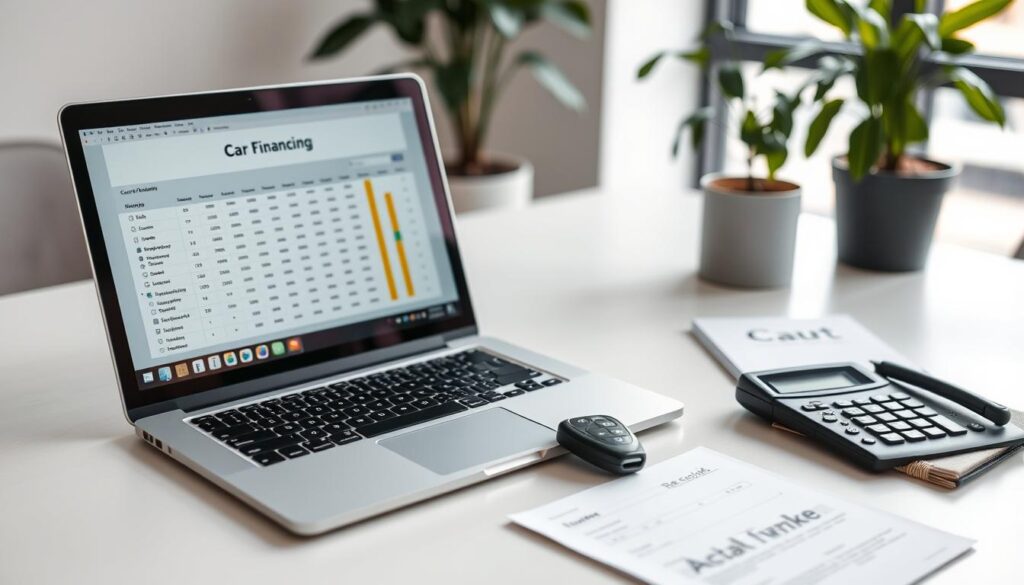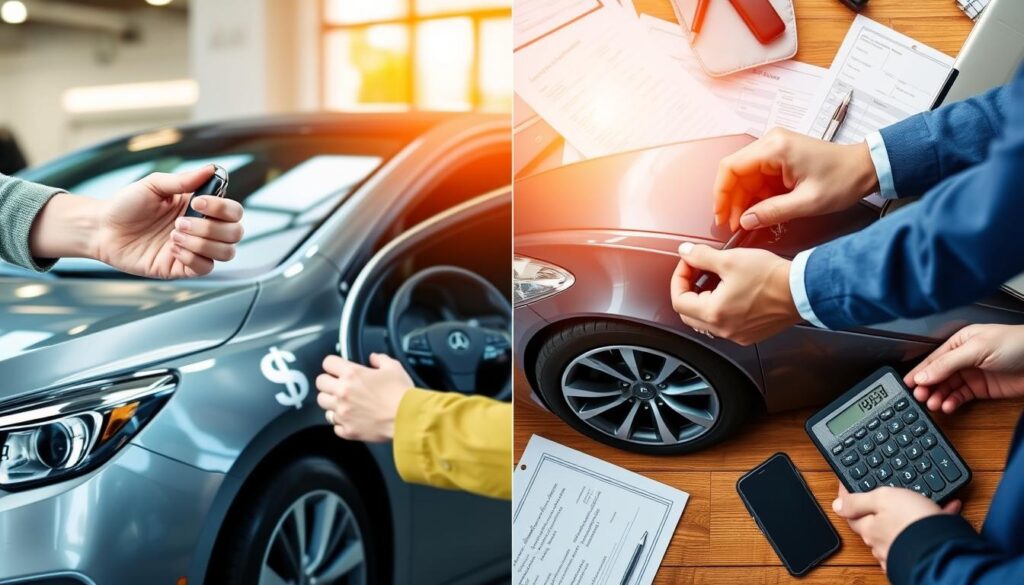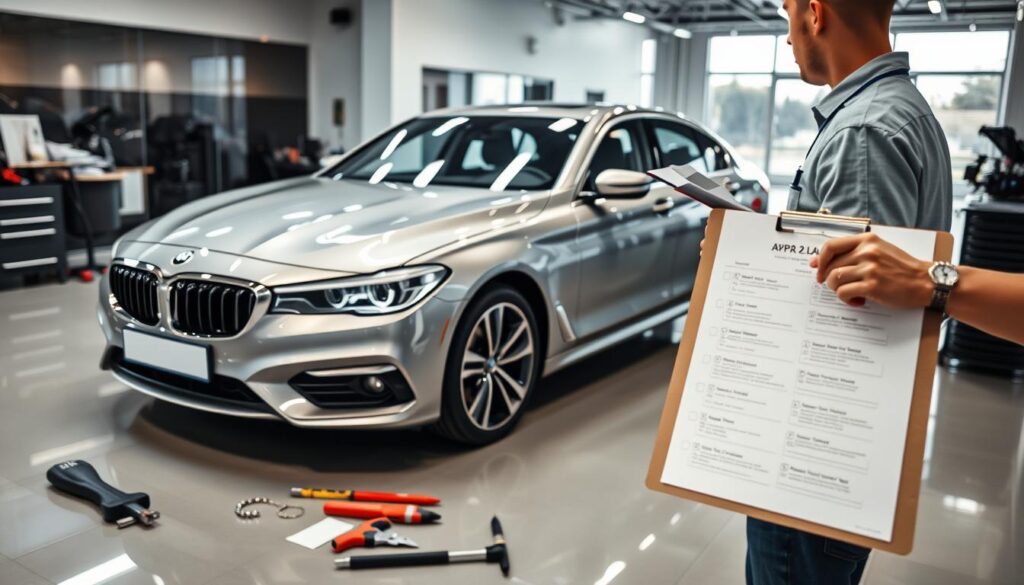Trading in a Financed Car-The What, How, and Why,Trading in a financed car can seem daunting, even in India. It’s key to grasp the car trade-in process if you’re looking to upgrade. This move can ease your financial load and boost your buying power for a new car. This article will guide you through important tips for financed vehicles and how vehicle equity affects your choices.
Table of Contents
By defining key terms and exploring the trade-in’s implications, you’ll be ready to make smart choices. These choices will align with your financial situation and needs.

Trading in a Financed Car-The What, How, and Why
Key Takeaways
- Understanding the car trade-in process is essential for upgrading your vehicle.
- Evaluating your vehicle equity can help you identify the right time to trade.
- Knowledge of financed vehicle tips can ease financial strain.
- Car financing in India presents unique factors to consider during the trade-in.
- Being informed about your financing situation can lead to a more beneficial trade.
Understanding Financed Car Trading
Trading in a financed car means you give your car to a dealership for credit on a new one. But, if you owe money on the loan, it’s a bit different. Knowing this can help you make smart choices and get the most out of your deal.
What Does It Mean to Trade in a Financed Car?
Trading in a financed car is more than just giving the keys. The dealer checks your car’s value and offers a trade-in amount. This amount can help pay off your loan, affecting how much you’ll owe. The car trade-in definition shows it’s a simple way to get a new car while handling your loan.
Common Misconceptions About Financed Cars
Many people think you can’t trade in a financed car. But, you can, if you know the financial side. Another myth is that trading in a financed car is too hard. But, with the right info, it’s actually quite easy.
| Myth | Fact |
|---|---|
| You can’t trade in a financed car. | You can trade in a financed car; the dealership will handle the loan payoff. |
| It’s too complicated to trade in a financed vehicle. | The process can be straightforward with proper preparation. |
| You’ll always owe more than your car’s worth. | Your car’s trade-in value can offset any remaining loan balance. |
Assessing Your Current Financing Situation
Before trading in your financed vehicle, it’s important to check your finances. Knowing your current loan status helps you prepare well. This ensures a smooth trade-in process. Focus on your loan balance and your car’s market value.
What to Check Before Trading
Start by gathering important loan and vehicle details. Look at these points:
- Outstanding balance on your car loan.
- Current market value of your vehicle based on reputable sources.
- Condition of your car, including any repairs needed.
- Your credit score, as it influences financing options for your next vehicle.
The Role of Equity in Your Car’s Value
Checking your car’s equity is key before trading. If your car’s value is more than what you owe, you have positive equity. This can help with your next car purchase. But, if you owe more, you have negative equity. Knowing this can help avoid surprises during the trade-in.

Trading in a Financed Car-The What, How, and Why
| Loan Balance | Market Value | Equity Status |
|---|---|---|
| $15,000 | $18,000 | Positive Equity ($3,000) |
| $20,000 | $18,000 | Negative Equity ($2,000) |
By doing these checks, you can make better choices for your car trade-in.
Trading in a Financed Car: The What, How, and Why
Trading in your financed car can make upgrading to a new vehicle easier. It can help lower your new loan amount. Plus, it saves you from the stress of selling your car privately.
The Benefits of Trading in Your Car
Trading in a financed car has many benefits:
- It makes buying a new car simpler.
- You might pay less for your new loan.
- Selling your car privately is avoided.
- Dealerships offer easier financing options.
The Process of Trading in a Financed Vehicle
Trading in your financed car involves a few steps:
- Get the payoff amount from your lender.
- Find out your car’s market value using Kelley Blue Book.
- Visit different dealerships for trade-in offers.
- Negotiate based on your car’s value and payoff amount.
- Finish the paperwork to transfer and cancel your loan.

Trading in a Financed Car-The What, How, and Why
Navigating the Trade-In Process
To successfully trade in your car, you need to plan well and make smart choices. Preparing for the trade-in can help you get a better deal. This means cleaning and fixing your car and knowing how to deal with local dealerships. Here are the main steps for a smooth trade-in experience.
Steps to Prepare for Your Trade-In
Here’s how to get ready for your trade-in:
- Clean your car thoroughly: Make sure the inside and outside are clean. A clean car makes a good impression.
- Perform minor repairs: Fix any broken parts, like lights or small dents. This can raise your trade-in value.
- Gather necessary documentation: Have your car’s title, loan details, and maintenance records ready for the dealership.
- Research your vehicle’s market value: Knowing what similar cars sell for can help you negotiate better.
Finding the Right Dealership
Choosing the right dealership is key in the trade-in process. Here are some effective strategies:
- Look for reputable dealerships with good reviews and a solid track record.
- Get quotes from several dealerships to find the best offer.
- Ask about resale values and how they decide trade-in offers.
- Consider dealerships that focus on your car’s make and model. They might offer higher trade-in values.
Understanding the trade-in process, from getting your car ready to picking a dealership, can greatly affect the value you get. This preparation is key for a successful and profitable trade-in experience.
What to Expect During the Trade-In
Trading in your vehicle involves several key steps, like the inspection and appraisal of your car. Knowing the trade-in inspection process helps you prepare. During the appraisal, dealerships check your car’s condition, mileage, and market demand. Being open about your car’s history and any issues can greatly affect the appraisal.
Inspection and Appraisal of Your Car
During the trade-in inspection, dealership reps will closely look at your car. They consider:
- Exterior and interior condition
- Engine performance
- Service history
- Mileage
- Market trends for similar vehicles
Being ready for this inspection helps show your car in the best light. Have all maintenance records ready and be ready to talk about any repairs. This will improve how your car is seen.
Negotiating Trade-In Value
After the appraisal, you’ll start negotiating your trade-in value. Knowing how to negotiate can help you get a better deal. Here are some tips:
- Research your car’s market value to have a good starting point.
- Know your car’s strengths and what makes it special.
- Understand the dealership’s appraisal to argue against low offers.
- Be ready to leave if the deal isn’t good enough.
Good negotiation can change the financial terms of your trade-in. Pay attention to how the dealer compares your car to others. This can help you negotiate better.

Trading in a Financed Car-The What, How, and Why
Potential Challenges When Trading In
Trading in a financed car might seem easy, but it has its own challenges. Knowing these challenges helps you handle the trade-in process better. Two big issues are negative equity and insurance during the trade-in.Trading in a Financed Car-The What, How, and Why
Negative Equity: What It Means for You
Negative equity happens when you owe more on your car than it’s worth. This makes trading in your car harder. For example, if your car is worth $15,000 but you owe $20,000, you have negative equity of $5,000. This amount must be settled before you can trade in your car.
- You might choose to roll over the negative equity into a new auto loan.
- Paying down the negative equity before trading can be beneficial.
- Considerations regarding how the lender assesses your financing options are critical.
Dealing with negative equity can be tough. But, many dealers are used to it. Talking openly about your situation can help find solutions.Trading in a Financed Car-The What, How, and Why
Insurance and Loan Considerations
Think carefully about your insurance when trading in your car. Changing cars can change your insurance needs. You might need to adjust your coverage, which can affect your budget.
Key considerations may include:
- Reviewing your existing insurance policy to ensure it covers your new vehicle.
- Understanding any gaps in coverage during the transition period.
- Shopping for the best rates or necessary changes in your coverage.
Being proactive about your insurance needs can make the transition smoother.
| Aspect | Negative Equity Implications | Insurance During Trade-In |
|---|---|---|
| Definition | Owing more than the vehicle’s value | Adjusting coverage based on new vehicle |
| Typical Challenges | Limited financing options, extra costs | Potential gaps in coverage |
| Recommendations | Consider rolling over debt, pay down loan | Review policy, compare rates |
Conclusion
Trading in a financed car needs careful thought about your current financing. Knowing your car’s equity and how financing affects its value is key. This knowledge helps you handle the process with confidence.
When you’re ready to trade in your financed car, follow some important tips. First, research the dealership and value your car to avoid surprises. Being prepared helps you clearly state your needs, making the trade-in smoother.Trading in a Financed Car-The What, How, and Why
Being well-informed about the trade-in process helps you make smart financial choices. By understanding the key steps and strategies, you’re ready to trade in your car. This ensures a better outcome for you.
FAQ
Can I trade in a financed car if I have negative equity?
Yes, trading in a financed car with negative equity is possible. You’ll need to understand the implications. You might have to roll over the remaining loan into a new one. Talking to your dealership can help clarify your options.Trading in a Financed Car-The What, How, and Why
What documents do I need to provide for a trade-in?
To trade in your financed vehicle, you’ll need some important documents. These include the vehicle title, loan payoff information, and registration. You’ll also need proof of insurance and any maintenance records. These documents help with the appraisal and negotiation.
How is the trade-in value of my financed car determined?
The dealer will inspect and appraise your car to determine its trade-in value. They consider your car’s condition, mileage, and market demand. This helps them offer a fair value for your vehicle.
Should I clean my car before trading it in?
Yes, cleaning your car before trading it in is important. It makes a good first impression and can increase its value. Make sure to clean both the interior and exterior and fix any minor issues.
What is the difference between trading in and selling my car privately?
Trading in your car is often more convenient and can give you credit towards a new vehicle. Selling privately might get you a better price but takes more time and effort.
What should I do if my car’s value is less than my loan balance?
If your car’s value is less than your loan, you have negative equity. You can talk to your dealer about options. They might suggest rolling over the negative equity into your new loan or other financing solutions.Trading in a Financed Car-The What, How, and Why
Can I negotiate the trade-in value of my financed vehicle?
Absolutely! Negotiating the trade-in value is encouraged. Knowing your car’s market value and being honest about its condition can help you negotiate better.
How does trading in a financed car impact my loan and insurance?
Trading in a financed car will pay off your existing loan, either through the dealer or a payoff amount. You’ll need to discuss your new financing and update your insurance to reflect your new vehicle.











One thought on “Trading in a Financed Car-The What, How, and Why”